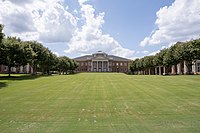
Photo from wikipedia
Employers in Science, Technology, Engineering, and Mathematics (STEM) fields report that recent graduates are deficient in important skills such as collaboration and professional writing. Scientific societies and science educators have… Click to show full abstract
Employers in Science, Technology, Engineering, and Mathematics (STEM) fields report that recent graduates are deficient in important skills such as collaboration and professional writing. Scientific societies and science educators have responded to the gap between student skills and employer expectations by recommending that undergraduate STEM curricula focus on cross-disciplinary, workplace-related skills in addition to discipline-specific skills and content knowledge. This study examined the disciplinary cultures in which STEM faculty teach and STEM students learn. We developed and validated the Survey of Teaching Beliefs and Practices for Undergraduates (STEP-U), which assesses the extent to which students value specific cross-disciplinary skills, as well as their experiences with teaching practices thought to reinforce such skills. We surveyed > 2000 students majoring in biological sciences, chemistry, physics, mathematics, and computer science. We interviewed five students from each discipline to supplement survey data. Next, we surveyed faculty members (N = 147) within these disciplines regarding the extent to which they valued the same cross-disciplinary skills and how this influenced their teaching practices. Student values differed according to academic discipline, classroom experiences, and individual characteristics, such as prior research experience. We offer a conceptual framework by which the relationship between faculty values, faculty teaching practices, and student values can be studied. Specifically, it predicts that faculty values are embodied in their teaching practices, and student values are shaped by their classroom experiences, leading to transmission of disciplinary values from faculty to students. Future studies should examine these relationships across different disciplines and institution types.
Journal Title: Journal of Science Education and Technology
Year Published: 2019
Link to full text (if available)
Share on Social Media: Sign Up to like & get
recommendations!